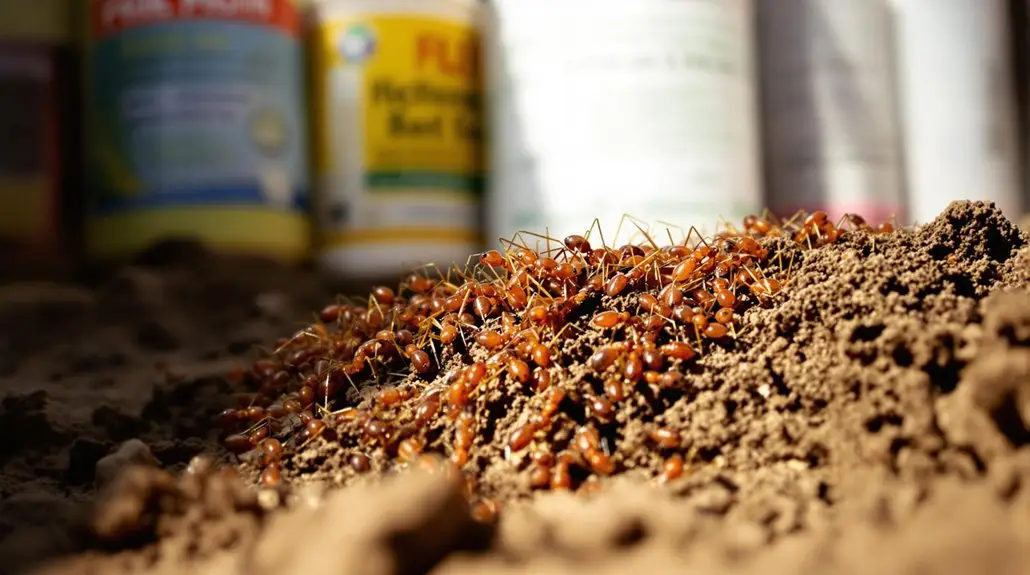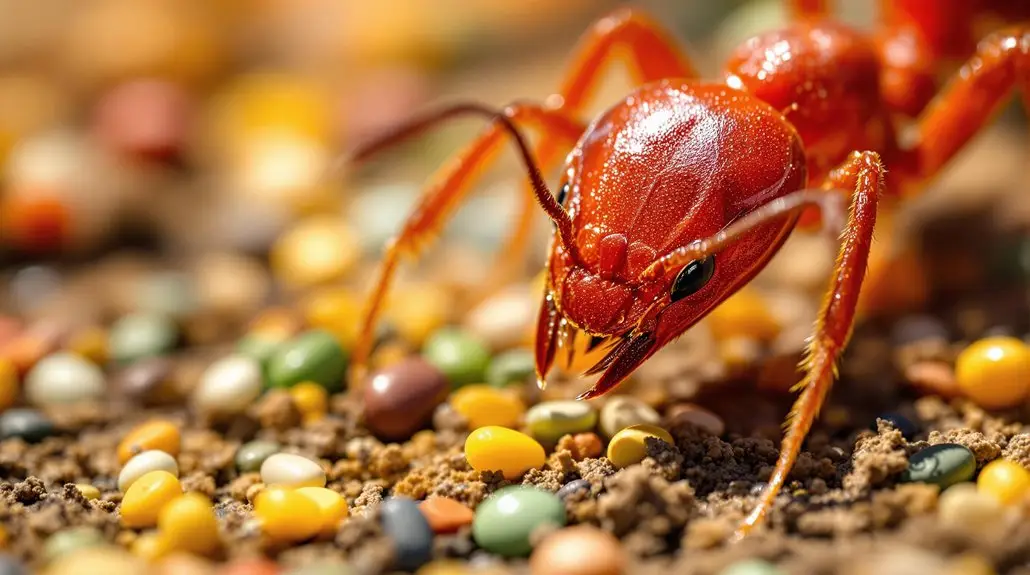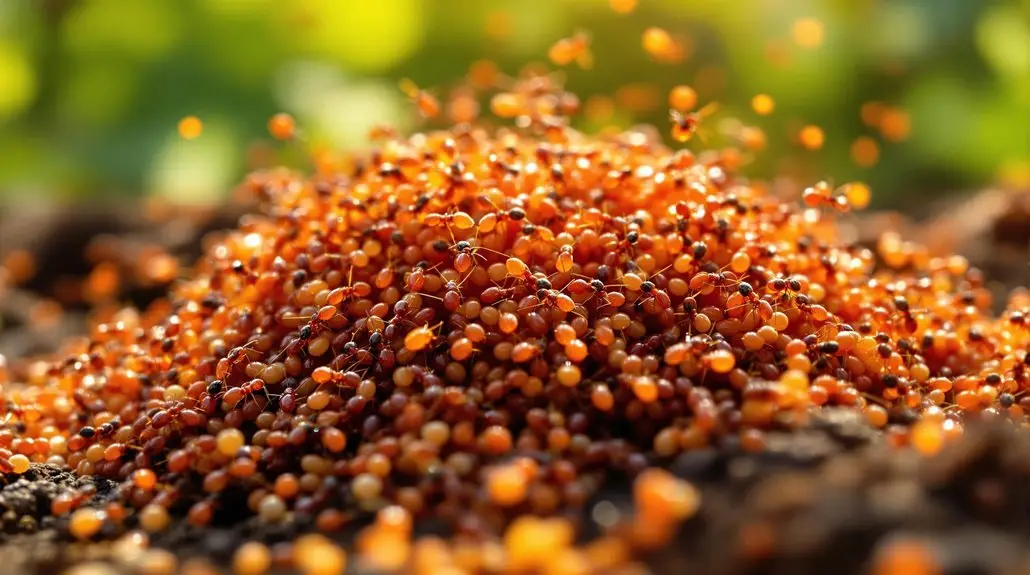The Red Imported Fire Ant, introduced to the U.S. in the early 1930s, has influenced treatment approaches considerably over time. Early control methods, including physical removal and toxic chemical applications, proved ineffective due to their limitations. Researchers shifted toward chemical baits, which allow for targeted, environmentally friendly control, thereby minimizing risks to non-target species. Advances in bait technology now enhance efficacy through better attractants and slow-release mechanisms. Continuing exploration in this field reveals further possibilities for effective management strategies.
Ready to Conquer Fire Ants in South Florida? Contact NaturePest Today!
Ready to reclaim your space from fire ants and protect your South Florida environment? Contact NaturePest Holistic Pest Control today for a tailored, eco-friendly strategy that promotes a healthy and sustainable ecosystem! Don’t let fire ants take over—let’s work together for a balanced solution.
Key Insights
- The Red Imported Fire Ant was introduced to the U.S. in the 1930s, leading to aggressive behavior and significant ecological impacts.
- Early control methods included physical removal and toxic chemicals, both of which were often ineffective and harmful to non-target species.
- The shift to chemical baits allowed for targeted control, effectively targeting colonies while minimizing harm to beneficial insects.
- Advances in bait technology improved effectiveness through enhanced attractants, slow-release mechanisms, and targeted nutritional profiles for fire ants.
- Integrated Pest Management (IPM) combines monitoring, cultural practices, and biological control to address challenges like resistance and ecological risks in fire ant management.
The Arrival of the Red Imported Fire Ant in the United States

Although many people may not realize it, the Red Imported Fire Ant (Solenopsis invicta) first arrived in the United States in the early 20th century, specifically around 1930, when it was accidentally introduced through shipping materials from South America.
This unintentional arrival marked the beginning of a significant ecological challenge, as these ants quickly adapted to their new environment, establishing large colonies that spread across the southern United States. Their aggressive behavior and painful stings posed a threat to local wildlife, pets, and even humans, altering the dynamics of ecosystems.
Researchers have since studied their invasive nature and the impact they’ve on agriculture and urban areas. As you explore this topic, you’ll discover how understanding the history of the Red Imported Fire Ant can inform effective control strategies.
Awareness of their arrival highlights the importance of monitoring and managing invasive species to protect our shared environments.
Early Control Methods and Their Limitations
In addressing the challenge of controlling red imported fire ants, early methods primarily focused on traditional physical removal and toxic chemical applications.
While these approaches aimed to reduce ant populations, they often proved limited in effectiveness, as physical removal could disturb the environment and chemical treatments posed risks to non-target species. Understanding these limitations is essential for developing more sustainable and effective control strategies in the future. Additionally, the shift towards eco-friendly products has become crucial in minimizing environmental impact while managing pest populations.
Traditional Physical Removal
Traditional physical removal methods for controlling red imported fire ants, such as handpicking and mound excavation, have been utilized since the ants first established themselves in new environments.
However, these methods come with significant limitations that often hinder their effectiveness.
- Labor-Intensive: Handpicking requires considerable time and effort, making it impractical for large infestations.
- Incomplete Removal: Mound excavation may leave behind queen ants or eggs, allowing colonies to quickly rebound.
- Disturbance: Physical removal can disrupt the surrounding ecosystem, potentially harming beneficial insects and plants.
While these traditional methods have been part of the historical approach to fire ant control, their limitations underscore the need for alternative strategies that could provide more effective and sustainable solutions.
Toxic Chemical Applications
As researchers explored methods to control red imported fire ants, they increasingly turned to toxic chemical applications, which were seen as a promising solution for managing large infestations.
Initially, these chemicals offered quick results, effectively reducing ant populations in a short period. However, over time, researchers discovered significant limitations. Many chemicals posed risks to non-target species, including beneficial insects and pets, raising concerns within communities.
Additionally, some fire ant populations developed resistance, rendering certain treatments ineffective. As a result, reliance on toxic chemicals became unsustainable, prompting the search for more environmentally friendly alternatives.
The Shift to Chemical Baits

While many pest control methods have been employed over the years to manage red imported fire ant populations, the shift to chemical baits has emerged as a particularly effective strategy.
This approach allows for targeted control, minimizing harm to non-target species and the environment.
Here are three key advantages of chemical baits:
- Delayed Action: Chemical baits contain slow-acting toxins that workers carry back to the colony, effectively targeting the queen and other ants.
- Attractiveness: These baits are formulated to entice ants, ensuring that they consume the product, which enhances the overall effectiveness of the treatment.
- Reduced Chemical Use: By focusing on baiting rather than broad-spectrum insecticides, there’s a significant reduction in the amount of chemicals released into the environment, promoting more secure pest management.
The change to chemical baits signifies a more strategic, environmentally conscious approach to combating this invasive species. Additionally, Integrated Pest Management (IPM) combines various control strategies, including the use of chemical baits, to improve overall effectiveness and safety in pest control.
Understanding Fire Ant Behavior for Effective Control
Understanding the behavior of red imported fire ants is vital for developing effective control strategies that can mitigate their impact on local ecosystems. These ants exhibit complex social structures, working collaboratively to build extensive underground colonies.
They forage in organized trails, allowing them to efficiently gather resources and communicate through pheromones, which are chemical signals. By recognizing these patterns, you can identify when and where to target control measures.
Furthermore, fire ants show a tendency to relocate their nests when disturbed, making it essential to apply control methods strategically. Observing their behavior during peak activity times, often in warmer months, can enhance the effectiveness of your efforts.
Additionally, understanding their reproductive cycles helps in timing treatments to disrupt population growth. By integrating this knowledge into your control strategies, you can foster a more harmonious coexistence with the environment while minimizing the ecological disruption caused by these invasive pests.
Advances in Chemical Bait Technology

Recent innovations in chemical bait technology have greatly improved how you can manage red imported fire ants.
By using advanced bait formulations and targeted delivery systems, researchers have enhanced the effectiveness of these products, ensuring that they attract and eliminate fire ants more efficiently.
Understanding these advancements can help you apply the most effective strategies for fire ant control in your area.
Innovative Bait Formulations
As researchers continue to explore effective methods for controlling red imported fire ants, innovative bait formulations have emerged as a significant advancement in chemical bait technology.
These formulations are designed to improve the effectiveness and efficiency of ant control, helping communities combat infestations.
Here are three remarkable advancements:
- Slow-Release Mechanisms: These baits allow for prolonged exposure, ensuring ants consume the bait over time.
- Attractant Enhancements: Researchers have identified more appealing attractants that entice ants, increasing bait consumption.
- Targeted Nutritional Profiles: Baits are now formulated to meet the specific dietary needs of fire ants, promoting more effective population control.
Targeted Delivery Systems
Targeted delivery systems represent a significant breakthrough in the field of chemical bait technology for controlling red imported fire ants, as these innovations enhance the precision with which baits are administered.
By focusing on specific areas where fire ants are active, these systems guarantee that the baits reach their intended targets more effectively, minimizing waste and reducing environmental impact.
Researchers have developed methods that utilize advanced formulations, which allow for slow release and improved palatability, guaranteeing that ants are more likely to consume the bait.
This targeted approach not only enhances control measures but also fosters a sense of community responsibility, as effective management of fire ant populations benefits everyone.
Integrated Pest Management Approaches
Integrated Pest Management (IPM) approaches for controlling red imported fire ants involve a strategic combination of methods that aim to minimize the use of chemical pesticides while maximizing effectiveness.
By adopting these integrated strategies, you can contribute to the overall health of your environment while effectively managing fire ant populations.
Here are three key components of IPM:
- Monitoring: Regularly check for fire ant activity to understand their presence and behavior in your area. This helps in making informed decisions about control measures.
- Cultural Practices: Implementing changes in land use, such as maintaining healthy lawns and removing debris, can reduce habitats that attract fire ants.
- Biological Control: Explore the introduction of natural predators or competitors to suppress fire ant populations, providing a sustainable alternative to chemical treatments. Additionally, utilizing eco-friendly solutions can significantly enhance your pest management efforts while protecting the environment.
Current Challenges in Fire Ant Management

While advancements in fire ant management strategies have been made, several current challenges persist, complicating efforts to control these invasive pests effectively. One significant issue is the development of resistance to commonly used insecticides, which reduces their effectiveness over time.
Additionally, the widespread distribution of fire ants across various regions makes it difficult to implement consistent management practices. The variability in environmental conditions further complicates treatment efficacy, as factors like temperature and moisture can influence the success of control measures.
Furthermore, public awareness and understanding of fire ant management often lag behind, leading to inconsistent application of recommended practices.
Finally, the integration of biological control agents poses its own set of challenges, including the potential for unintended ecological consequences.
Future Directions for Research and Control Strategies
As researchers continue to explore innovative methods for managing red imported fire ants, it’s essential to focus on developing strategies that not only address current challenges but also anticipate future needs in pest control.
To guarantee effective management, consider the following key directions for research and control strategies:
- Biological Control Agents: Investigating natural predators or pathogens that can effectively reduce fire ant populations without harming the ecosystem.
- Sustainable Practices: Developing environmentally friendly control methods that minimize chemical use and promote ecological balance.
- Public Education and Engagement: Creating outreach programs that inform communities about fire ant identification, prevention, and management techniques.
Frequently Asked Questions
What Environmental Impacts Do Red Imported Fire Ants Have?
Red imported fire ants considerably impact ecosystems by preying on native species, disrupting local food webs. Their aggressive nature allows them to outcompete native ants for resources, leading to declines in biodiversity.
Additionally, they can damage crops and harm livestock through painful stings. Their extensive nesting behavior can cause soil erosion, altering habitats.
These factors collectively illustrate the importance of managing fire ant populations to protect ecological balance and agricultural productivity in affected areas.
How Do Red Imported Fire Ants Affect Local Wildlife?
Imagine a world where fire ants wielded swords; in reality, they’re formidable predators that disrupt local wildlife.
You’ll find they outcompete native species for food resources, reducing biodiversity. Birds, small mammals, and reptiles often fall victim to their aggressive foraging behavior and painful stings.
These interactions alter food webs, as native species struggle to survive in the presence of these invasive ants, leading to significant ecological shifts in affected habitats.
Are There Any Natural Predators of Fire Ants?
Yes, several natural predators of fire ants exist, which help regulate their populations.
Certain birds, like the Loggerhead Shrike, consume fire ants, while specific parasitic flies, such as the Phorid fly, lay eggs within the ants, leading to their demise.
Additionally, some nematodes and other insects have shown potential in controlling fire ant numbers.
Research continues to explore these natural options, aiming to enhance biological control methods for fire ant management effectively.
Can Fire Ants Damage Agricultural Crops?
Imagine vibrant fields teeming with crops, suddenly threatened by an unseen menace.
Yes, fire ants can indeed damage agricultural crops. Their aggressive foraging behavior disrupts plant roots, while their nests can create unsightly mounds, affecting harvesting equipment.
Additionally, the ants can protect crop-damaging pests, such as aphids, fostering a detrimental environment for farmers. Consequently, their presence poses significant challenges to agricultural productivity, necessitating effective management strategies to mitigate these impacts.
What Are the Signs of a Fire Ant Infestation?
You’ll notice signs of a fire ant infestation primarily through their distinctive mounds, which can vary in size and shape, often appearing in sunny areas.
When you disturb these mounds, you may observe aggressive ants swarming out, ready to defend their territory.
Additionally, you might find piles of soil near the mounds and witness damage to plants, as these ants can disrupt root systems while foraging for food.
Final Thoughts
The Path Forward in Fire Ant Management
Conquering the Fire Ant Challenge: Join the Fight for a Balanced Ecosystem!
To sum up, managing the red imported fire ant requires a multifaceted approach, blending advances in chemical bait technology with a thorough understanding of ant behavior. Just as a skilled gardener knows when to prune and nurture, researchers must continue refining strategies to effectively control this invasive species. By integrating innovative bait solutions with extensive pest management practices, we can mitigate the challenges posed by fire ants, ensuring a balanced ecosystem for future generations.
If you’re in South Florida and looking for effective fire ant control, consider partnering with NaturePest Holistic Pest Control. Together, we can develop a tailored strategy to protect your environment while promoting a healthy and sustainable ecosystem. Don’t let fire ants take over—contact us today!

